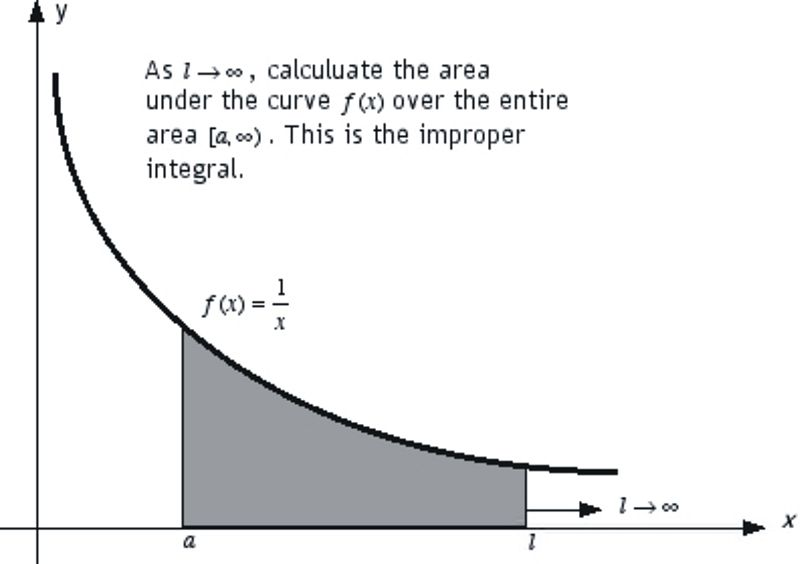Objective: Solve the different types of improper integrals
Definition. An improper integral is an integral where one or the two limits of integration are infinite. An integral is also improper when the function has an infinite discontinuity. Let's look at the two scenarios:
I. One or two of the limits of integration are infinite.
a. One of the limit of integration is finite,
If f is continuous over the interval [a, +∞[, then
If the limit is finite the integral converges. If the limit is infinite the integral diverges.
Geometric Interpretation

Let's consider a function f(x) = 1/x. The integral 
represents the area under the curve of the function that starts from the vertical passing by a and extending to infinity.
The integral

represents the area between the verticals passing by a and l. As l approaches infinity, the area under the curve spreads to infinity. It's fair to say that this situation represents

.
We can define

as the limit of

when l approaches infinity.
We can then set a rule to calculate the improper integral where the lower limit is finite and the upper limit is infinite. In this case we have to replace the infinite limit by l and find the limit of

when l approaches infinity.
Example 1. Calculate
 Solution
Solution
Let's replace infinity by l and calculate the limit of the finite integral when l approaches infinity.
We have:
b. The two limits of integration are infinite
In this case we choose any value a in the interval ]-∞, +∞[ and calculate the integral over the sub-intervals
]-∞, a[∪ ]a , +∞[
Example 2. Evaluate

Solution
Let's split the integral over the intervasl ]-,0] and [0,+[:
Let's evaluate the first integral on the right side:
Let's calculate the limit by substituting l by -∞:
Let's evaluate the second integral:
Let's substitute the two integrals we obtain:
II The function to integrate is discontinued.
Let's say that we have to calculate an integral over an interval ]a, b[ where the function f is continued. If the function isn't continued at a point c of the interval, we evaluate the integral over the intervals ]a,c[∪]c,d[.
Example. Evaluate
 Solution
Solution
The function is discontinued at x = 1. Therefore we integrate it over the 2 intervals ]0,1[∪ ]1.4[.
 Let's calculate the first integral:
Let's calculate the first integral:
 = ln │1⁻-1│-ln1
= ln o⁺
= -∞
= ln │1⁻-1│-ln1
= ln o⁺
= -∞
Since the first integral diverges there's no reason to calculate the second integral. The given integral diverges.
Exercises
Evaluate. Tell if the integral converges or diverges:
If you want to learn more about Calculus check this site
Center for Integral Development
.




































